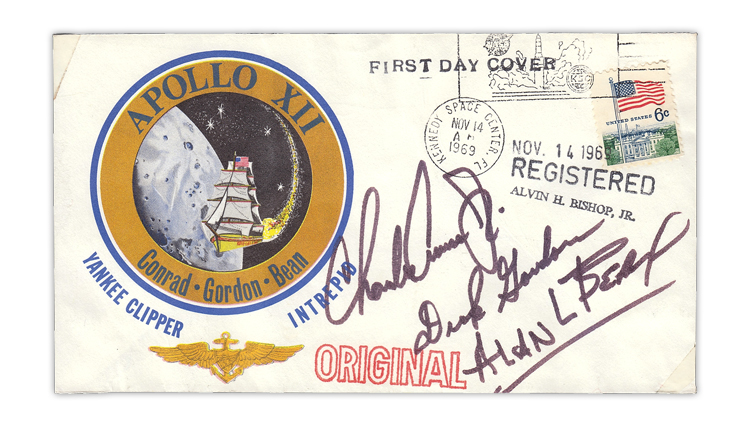US Stamps
Inside Linn’s: A not-so-reassuring Apollo 12 insurance cover

By Charles Snee
The April 12 issue of Linn’s Stamp News just landed on the presses and goes in the mail to subscribers Monday, March 29. And if you subscribe to Linn’s digital edition, you’re at the head of the line with early access Saturday, March 27. While you wait for your issue to arrive in your mailbox, enjoy these three brief summaries of exclusive content available only to subscribers.
A not-so-reassuring Apollo 12 insurance cover
“So-called insurance covers were created by the astronauts on Apollo flights 11 through 16 as a way to help provide for their families if they did not return from their missions,” explains Wayne L. Youngblood in The Odd Lot. Apollo insurance covers, which bear the signatures of the astronauts, are very popular among astrophilatelists. Youngblood begins with a brief history of their origins before presenting an Apollo 12 insurance cover that isn’t particularly reassuring. This is because all but two elements on the cover, the 6¢ Flag Over White House stamp and the decorative cachet created by Alvin Bishop, are fake. Youngblood also illustrates a genuine Apollo 12 insurance cover for comparison. He methodically shows how the fake differs from the genuine. One of the differences is the stamp on the fake, which is not the correct issue for an Apollo insurance cover. Read the column to learn which stamp is found on genuine Apollo insurance covers. Hint: It’s an airmail stamp.
International business reply mail processed for return to the U.S.
Tony Wawrukiewicz, in Modern U.S. Mail, continues his exploration of international business reply mail that began in his column in the Feb. 8 issue of Linn’s. This month he highlights two covers “returned from a foreign country where foreign postage was used to return the items, but the items were not on the top of a stack of returns, so neither has postage due stamps affixed.” For each cover Wawrukiewicz explains how the franking satisfied the airmail rate in effect at the time. The cover returned from Costa Rica in 1969 is franked with Costa Rican stamps totaling 65 centimos paid, and the 1976 cover from the Netherlands is franked with a single 1972 50¢ lilac Queen Juliana definitive. Wawrukiewicz also provides helpful details concerning the domestic business reply mail postage and associated fees that each recipient had to pay once the covers arrived in the United States.
Journal Entries: ‘Precancel Forum’
Linn’s Journal Entries column reports on recent journals and similar publications from national and international organizations. In this week’s column, Michael Baadke reviews the March issue of Precancel Forum, the monthly newsletter of the Precancel Stamp Society, which has been in existence for almost 85 years. Baadke focuses on a fascinating article about a missing-letter variety on a Marysville, Mich., precancel by dealer and precancel specialist Arnold Selengut. An illustration taken from Selengut’s article shows several stamps with the Marysville precancel variety, which is missing the second L in “Marysville.” “The society’s work in documenting and publishing research on precancels is nothing short of amazing,” Baadke writes. If you collect precancels, consider joining the Precancel Stamp Society. You’ll be glad you did.
Connect with Linn’s Stamp News:
Sign up for our newsletter
Like us on Facebook
Follow us on Twitter
MORE RELATED ARTICLES
Headlines
-
World Stamps
Oct 8, 2024, 3 PMRoyal Mail’s Oct. 1 definitive meets new international standard rate
-
World Stamps
Oct 8, 2024, 12 PMPostcrossing meetup Oct. 9 at U.N. headquarters
-
Postal Updates
Oct 7, 2024, 5 PMUSPS plans to raise postal rates five times in next three years
-
US Stamps
Oct 7, 2024, 3 PMMcMurtrie dismissed as APS education director following Sept. 21 arrest








